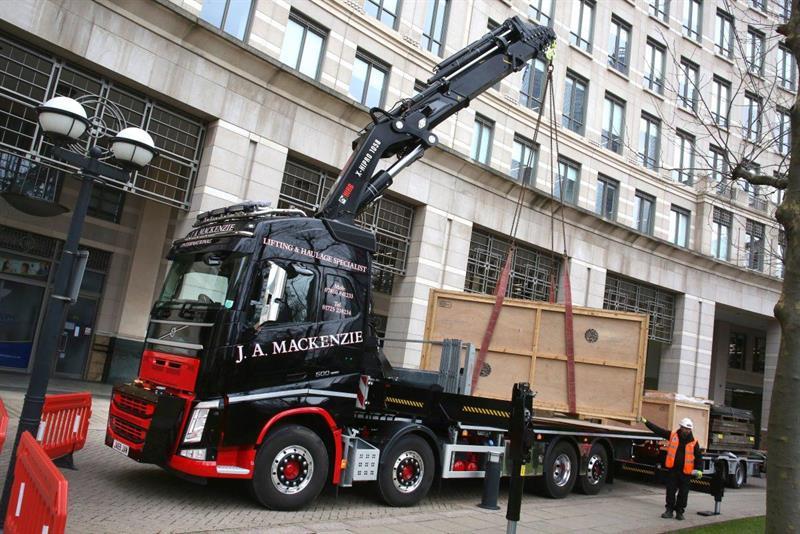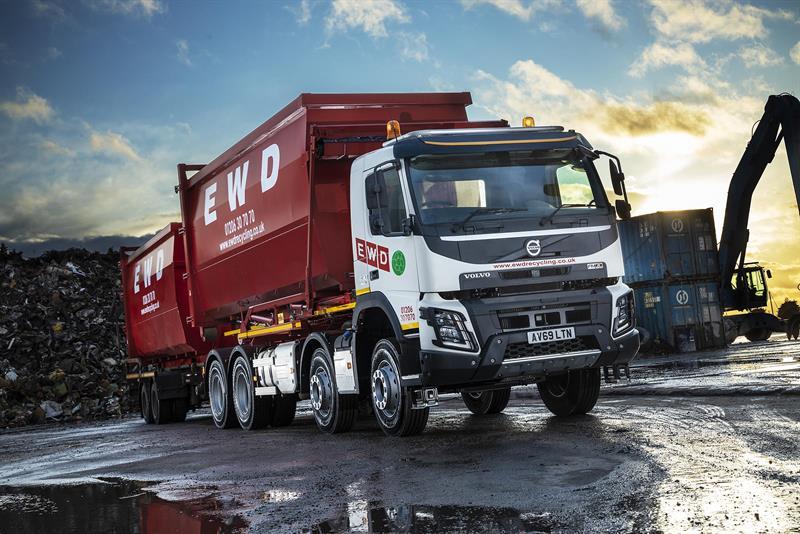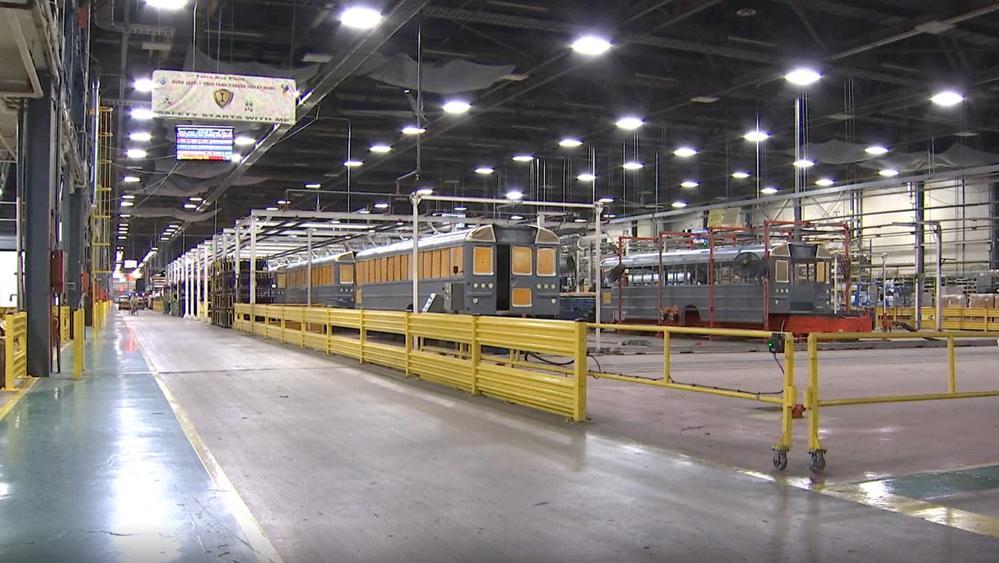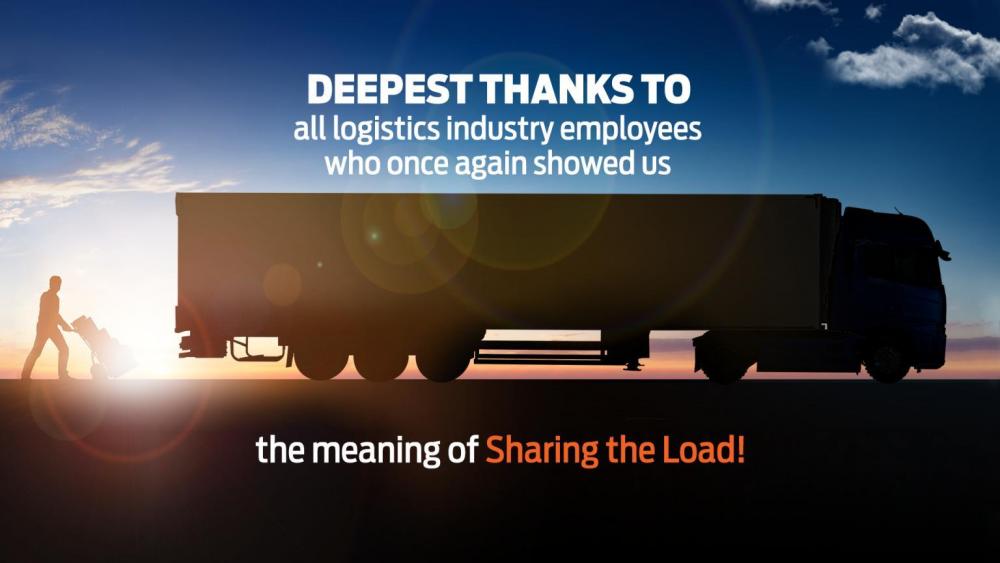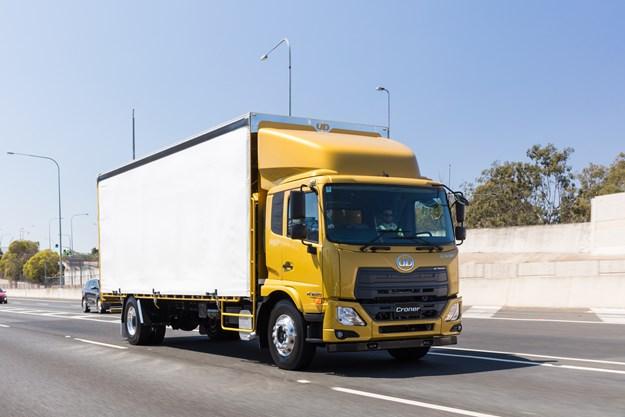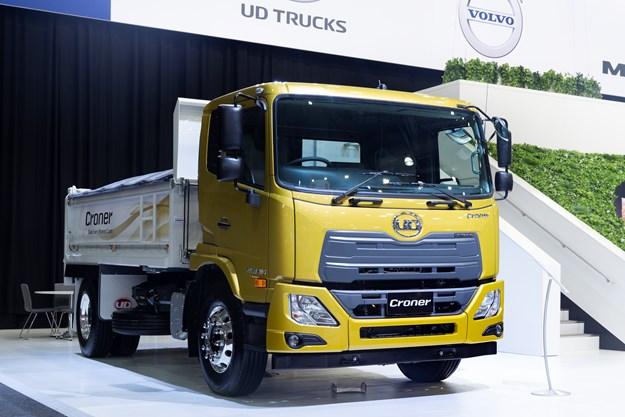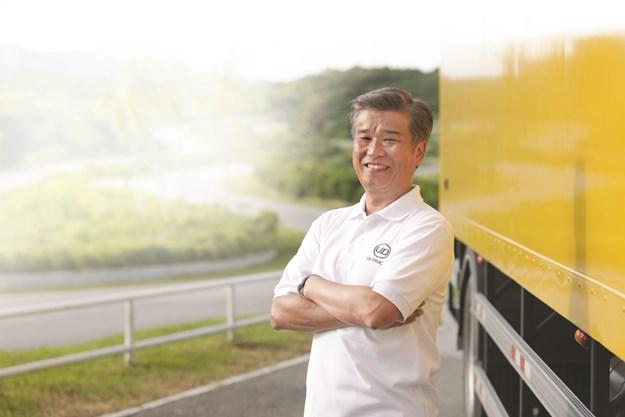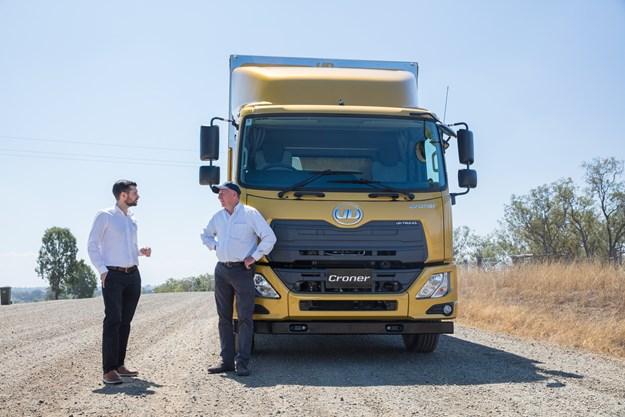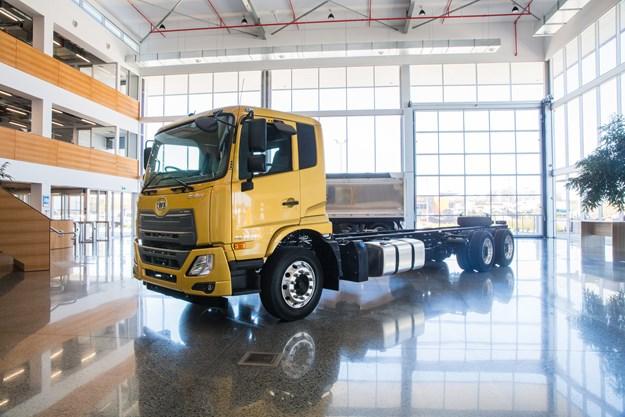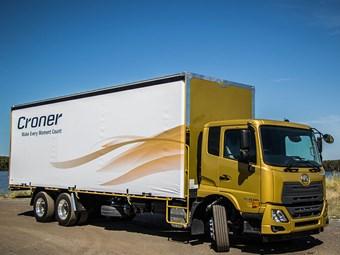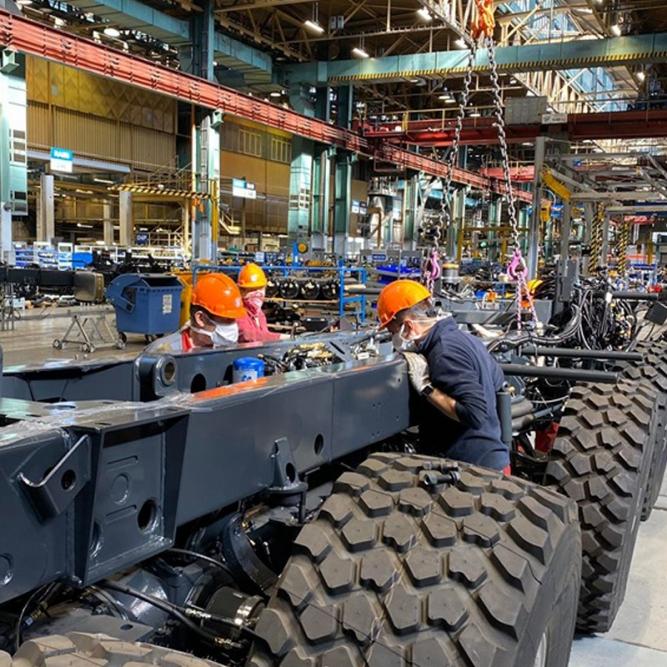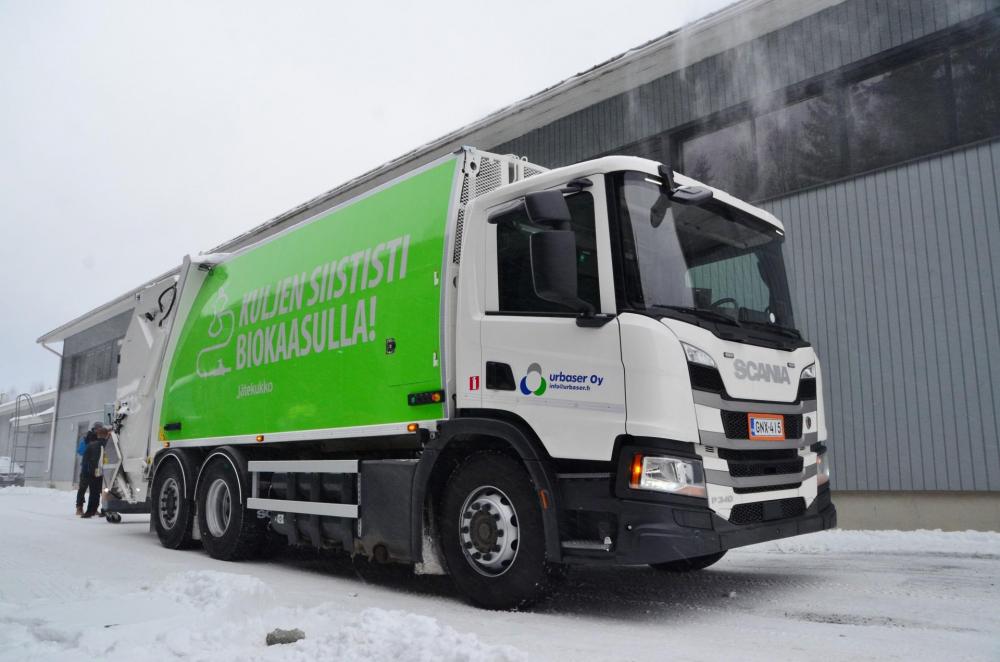
kscarbel2
Moderator-
Posts
18,539 -
Joined
-
Days Won
112
Content Type
Profiles
Forums
Gallery
Events
Blogs
BMT Wiki
Collections
Store
Everything posted by kscarbel2
-
Transport Engineer / May 7, 2020 The Volvo FH500 GT 8x2 unit incorporates a Hiab 1058 crane featuring ten hydraulic extensions, giving the vehicle a lifting capability of 2.5 [metric] tonnes at a reach of almost 24 meters. Built at MV Commercial’s Airdrie site, the new truck will support JA Mackenzie Haulage’s specialist transport operations for works of art and public sculptures. Jimmy Mackenzie, managing director of the company, says: “Our work often includes very unusual lifts such as loading priceless paintings through gallery windows, where precision and control are essential. We required something very special – and MV Commercial’s design team stepped up to the challenge, and were able to deliver a truck that matched our precise specifications.” The new vehicle replaces an older asset and includes a range of tailored features designed to make lifting irreplaceable artwork quick, easy and safe. The detailed specification of the cab includes NATO-spec legs for increased stability, and food cooking and storage facilities for overnight travel. Meeting the requirements of FORS Gold, the truck also incorporates a 50mm air-operated drawbar coupling and remote control of the rear extender, while the hydraulic tank has been moved on to the crane itself to create more space on the chassis. .
-
Transport Engineer / May 4, 2020 Colchester, Essex-based EWD Recycling has bought an order for four new Volvo FMX 8x4 rigids from Volvo Truck and Bus Centre East Anglia for its waste disposal and waste recycling services for industrial and domestic users across the east of England. It operates a predominantly Volvo fleet of 30 HGVs in a demanding on/off-road application. The order includes two FMXs with Boweld steel tipping bodies and a second pair with Hyva hookloader bodywork and drawbar couplings. All four 32-tonners use the Volvo D11K Euro 6, Step D, diesel engine which produces up to 424bhp and 2,050 Nm of torque over a wide maximum torque range from 1,000 to 1,400 rpm. EWD Recycling has specified each vehicle’s day cab with a programmable night heater, enabling its drivers to arrive at work and step into a pre-warmed cab when their shifts begin at 6am. This also allows them to stay warm on colder days when waiting to load or unload, without needing to keep the engine running – saving fuel and reducing emissions. Purchased outright, the trucks have been supplied with a three-year Volvo Silver Contract which covers all preventive maintenance and driveline repairs within the Volvo Trucks dealer network for a fixed monthly amount. This helps to protect the firm’s operator’s licence and minimises the risk of unscheduled downtime. All routine maintenance will take place at Volvo Truck and Bus Centre East Anglia’s Ipswich site, which offers late night and Saturday opening. Danny Cook, manager at EWD Recycling, says: “Our drivers absolutely love the Volvos. We need vehicles which can cope being worked hard in this kind of environment and we get very good uptime from our FMXs. “On the rare occasion something needs looking at, we can drop a vehicle off at our local dealership at the end of the day, and know it will be sorted by morning. We can’t afford a truck off the road; and it’s this level of service which keeps us coming back.” .
-
City finds millions of dollars in repair needs at Navistar bus plant
kscarbel2 replied to kscarbel2's topic in Trucking News
. -
City finds millions of dollars in repair needs at Navistar bus plant
kscarbel2 replied to kscarbel2's topic in Trucking News
Navistar, City Of Tulsa Dispute Over Rent News On 6 / April 6, 2020 One of Tulsa’s largest employers accuses the City of trying to evict them from their building. Navistar leases part of the Air Force Plant #3 at the airport, but a 20-year lease expired in January, and the two sides can’t agree on terms for a renewal. The negotiations started two years ago, according to the City, and both sides agree the dispute centers on maintenance needs for the building. The City requires Navistar to maintain the property as part of the lease, but the City claims Navistar has put it off. Plant Manager Randy Tharp said the company spend $1 million each year on maintenance and the building is suitable as is for their needs. The company launched a website with claims the City wants to evict Navistar and in response the City released documents detailing their efforts to extend the lease and reach an agreement on the maintenance. Navistar employs 1,600 people at the bus plant, which turns out 74 buses each day. Tulsa Mayor G.T. Bynum said, “The main financial requirement of that lease is that they maintain the building, and then they don't it?” in arguing it wouldn’t be good stewardship of City assets to let the maintenance needs lapse. The City claims an independent inspector found millions of dollars in overdue maintenance, and that Navistar’s own inspectors found similar issues. Tharp, the Plant Manager, said the City’s termination letter for the original lease, raised alarms for the employees. “When we get a letter that says we're terminating your lease, that hits home, to 1,600 people.And we want to be heard” said Tharp. Bynum said the City won’t agree to a long-term lease without a written plan for repairs. The current extension runs through the end of May. Bynum said the notion the City wanted to evict Navistar was not true. “Why they would say that to their employees, and their employees’ families in the middle of this economic crisis? For the life of me, I can't understand it, except that it's a hard ball negotiation tactic,” said Bynum. -
Steve Berg, KRMG / May 6, 2020 Major maintenance problems have been found at the Navistar school bus assembly factory in north Tulsa. That's the word from Tulsa Mayor G.T. Bynum, who says the city found millions of dollars in repair needs during inspections, as part of their process to work out a new lease with the company. Navistar leased the giant building 20 years ago for just one dollar, but with the understanding they would pay for the upkeep. Mayor Bynum says they haven't maintained the building sufficiently, but he stresses he wants Navistar to stay in Tulsa. “But we recognize we can't keep them here for the long haul, if the building gets run into the ground,” Bynum said. Mayor Bynum points out these are not minor cosmetic issues. He says there are problems with the roofing and electrical systems that affect the building's structural integrity. .
-
Cummins Press Release / May 5, 2020 What do sand bags, mountains, a drone and a film crew all have in common? Well, not much, except that they were all an important part of GILLIG and Cummins’ effort to illustrate the extent of the testing and validation process for the Cummins-powered GILLIG battery electric bus. .
-
Door window weatherstripping
kscarbel2 replied to Quickfarms's topic in Exterior, Cab, Accessories and Detailing
For both doors, you need 4 pieces of Mack part number 440SX30A. The 440SX30A is for the tracks on the removeable door panel, and the upper section of the door (you'll need to cut/shorten that upper piece). You only use the included brass retaining clips on the removeable door panel tracks. The vent window post felt is different, and is (was) sold under a vendor number 2795-170014005 (1 per vent window). The roll-up window "wipers" are Mack part numbers 35RU223 and 35RU224 (2 each). -
Gold bulldog base?
kscarbel2 replied to Bigdogtrucker's topic in Antique and Classic Mack Trucks General Discussion
The chrome base is 14MF45P1. A P2 variant existed (14MF45P2) but I can't confirm if it is gold. Of course the 27RU217B(P1) is a chrome dog, and a 27RU217BP2 is a gold dog. -
GM stays profitable in Q1 despite shutdowns Hannah Lutz, Automotive News / May 6, 2020 DETROIT — General Motors' first-quarter net income plunged 87 percent, but earnings in North America rose even as the coronavirus pandemic drove production to a standstill. The $294 million profit made GM the only one of the Detroit 3 to avoid a first-quarter loss after the companies closed all of their U.S. plants in mid-March. GM said the crisis reduced its adjusted earnings by $1.4 billion before interest and taxes. Fiat Chrysler Automobiles posted a first-quarter net loss of $1.8 billion, and Ford Motor Co. lost $2 billion. Ford warned that its operating loss would exceed $5 billion in the second quarter. GM said it aims to reopen most plants in the U.S. and Canada on May 18, mirroring a plan announced Tuesday by FCA. Despite the plants being closed for the last two weeks of the quarter, strong sales of pickups and big SUVs pushed North American profits to $2.2 billion, a 16 percent increase from the first quarter of 2019. Global revenue fell 6.2 percent to $32.7 billion, and the company's profit margin decreased 2.8 points to 3.8 percent. Adjusted earnings before interest and taxes decreased 46 percent to $1.25 billion. GM shares surged 7 percent to $22.75 in morning trading in New York. Struggles ahead CFO Dhivya Suryadevara said GM would be hit harder in the second quarter but declined to provide any projections for that period or the full year. "We are not providing formal guidance at this time," she said on a conference call. "It's too early to tell until the economy opens up." In a statement, GM said it intends to resume "the majority of manufacturing operations on May 18 in the U.S. and Canada under extensive safety measures." That plan, which is being developed in coordination with the UAW and government officials, would mean the company missed out on about two months' worth of production. UAW President Rory Gamble, in a statement Wednesday, did not object to GM's May 18 restart date after calling earlier plans to reopen plants as of May 4 "too risky." "The companies contractually make that decision and we all knew this day would come at some point," the statement said, echoing what the union said Tuesday about FCA's restart plans. "Our UAW focus and role is and will continue to be, on health and safety protocols to protect our members." GM's international regions lost $551 million in the first quarter, vs. a gain of $31 million a year earlier, and China equity income fell $543 million, primarily because of coronavirus shutdowns in that country. Earnings from GM Financial decreased 36 percent to $230 million. Suryadevara said the pandemic has resulted in minor product changes, such as deferred freshenings, but has not interrupted GM’s work on electric and autonomous vehicles. In March, GM invested $20 billion in EV and AV development, and the automaker has said it plans to launch 20 EVs globally by 2023. 'Continue as planned' “Our key product programs … whether it’s our full-size SUV franchise or EV and AV… they will continue as planned,” she said. GM is in a unique position in its product cycle, she added. The automaker had already launched all-new architectures for a variety of platforms before the pandemic. “If you look at the product cadence that we are on, we happen to be in the sweet spot where we have made a lot of the investment already from an ICE perspective,” Suryadevara said. When plants reopen, GM will prioritize profitable products that dealers are running low on, such as pickups, she said. “Obviously truck is our strong suit and that's something we are we're going to capitalize on,” she said. Visits to GM’s Shop-Click-Drive online car-shopping tool have increased 40 percent during the pandemic, she said. About 3,500 GM dealerships have access to the tool, an increase of about 800 since the crisis started and many dealers converted to virtual sales. GM is on track with the restructuring plan it launched in 2018, Suryadevara said. It expects to contribute $6 billion in cash savings by the end of this year, and in the first quarter, GM put another $300 million toward that goal, she said. Liquidity measures GM ended the quarter with $33.4 billion in automotive liquidity, including $16 billion recently drawn from revolving credit lines. The automaker bolstered its cash reserves by reducing paychecks for all salaried employees globally by 20 percent, promising to make up for the lost income within a year. It also extended $3.6 billion under its three-year revolving credit agreement, and GM and GM Financial renewed their 364-day $2 billion revolver. The automaker has been stoking demand during the crisis with no-interest, 84-month loans and deferred payments of up to 120 days to customers in top credit tiers. GM last week created a health and safety manual to instruct team leaders on the company's new safety protocol. "In these uncertain times, we must focus on controlling what we can, and we will continue to take the appropriate actions. As the COVID-19 situation continues to evolve, we are ready to adapt and make any changes to policy in accordance with relevant health and safety protocols issued by authorities," CEO Mary Barra and Jim Glynn, vice president of global workplace safety, said in the 48-page guide. GM's manual outlines requirements for physical distancing, wearing face masks and safety glasses, and participating in health questionnaires and temperature screenings. GM's housekeeping team will clean high-traffic areas three to four times per shift, as well as between shifts. Doors will be propped open when possible to increase airflow and eliminate the need for workers to touch them.
-
New York Governor Andrew Cuomo said Friday that Coronavirus arrived in his state from Europe and that 2.2 million people flew in from European countries in January and February, while the world was oblivious to the threat and assumed it could only come from China. Cuomo says that between January and March, 2.2 million people arrived in New York on flights from Europe. At the time, Europe was mistakenly not being considered a hotspot. “Last November, December... we knew China had an outbreak. Researchers now say the virus was spreading wildly in Italy in February. Researchers now say there were likely 28,000 cases in the US in February including 10,000 in the state of New York. It came from Europe. When you look at the number of flights that came from Europe to New York in January and February, up until the close down in March... 13,000 flights bringing 2.2 million people. We acted two months after the China outbreak. When you look back, does anyone think the virus was still in China, waiting for us to act? Two months later? We all talk about the global economy and how fast people move and how mobile we are. How can you expect that when you act two months after the outbreak. The horse had already left the barn by the time we moved. Those are the flights coming from Italy and Europe in January and February. We closed the front door with the China travel ban, which was right, but we left the backdoor open because the virus had left China by the time we did the China travel ban. That's what the researchers are now saying. What is the lesson? An outbreak anywhere is an outbreak everywhere. When you see November and December in China, just assume the next day that it's in the US. When they say it's in China, assume that the virus got on a plane that night and flew to New York or Newark and it's now in New York. That has to be the operating mentality because you don't know the virus didn't get on a plane. All you need is one person to get on that plane in China and come to New York. You can't assume two months after the virus is going to be sitting on a park bench in China waiting for you to get there. It will happen again. Bank on it. Let's not put our head in the sand and say this is the only global pandemic we'll ever have to deal with.” Coronavirus was spreading silently through US cities including New York, Chicago, Boston, San Francisco and Seattle in February when the world was worried only about China. Researchers from Northwestern University have estimated that based on lockdown orders, confirmed cases and people's traveling and moving habits, the true number of people infected across those five cities by March 1 was 28,000, even though only 23 cases had been confirmed at the time via testing.
-
Ford Bronco, Bronco Sport to feature multiple grilles Michael Martinez, Automotive News / May 5, 2020 Customers in the market for Ford Motor Co.'s upcoming offroaders will have at least a couple grille options. The automaker plans to offer three front-end designs for both the Bronco SUV and Bronco Sport crossover, according to Ford Authority. They'll reportedly be called "Modern," "Classic" and "Custom." Spy photos recently posted on broncosportforum.com appear to show two of the three designs for the smaller crossover. Both the Bronco and Bronco Sport were scheduled to be revealed by now but have been postponed indefinitely due to the coronavirus crisis. Uncamouflaged photos of both vehicles have already leaked. The photos show the word BRONCO stamped in the middle of each grille, flanked by the vehicle's classic round headlights. Ford told suppliers this week it now plans to begin mass output of the Bronco Sport at a plant in Mexico on Aug. 31. Output was first planned to start on July 13 then pushed to Sept. 7 because of the coronavirus outbreak. The Bronco will be built on a body-on-frame architecture shared by the Ranger midsize pickup, while the Bronco Sport will sit on the same unibody platform as the recently redesigned Escape and Lincoln Corsair. Ford executives have vowed to make the Bronco highly customizable, with plans for hundreds of parts and accessories to boost dealers' bottom lines.
-
Quest for UD Croner an international affair Steve Brooks, Australasian Transport News (ATN) / May 2, 2020 The new medium-duty offering comes at a time of flux in Japan, Sweden and Australia The upcoming launch of UD’s Thai-built Croner marks the culmination of a remarkable development program driven as much by commercial necessity as engineering initiative. More to the point though, it graphically illustrates Volvo Group’s inherent ability and acute willingness to draw on diverse global platforms to satisfy the demands of a particular market. In this case, a particularly demanding market. Ours! Masami (Mat) Ozono is a proud Japanese man who for more than 40 years has inched his way up the ladder of executive engineering appointments at UD. Fortunately for me, his English is good and more fortunately for UD and its leagues of customers, his experience and passion for the brand are profound. Even better, and somewhat outside the square of standard Japanese response, he doesn’t appear at all shy about delivering a sharp answer to a blunt question. Anyway, as senior manager of product management and planning, Ozono-san has been at the pointy end of UD’s Croner development program since the decision was taken in 2013 to design and build a replacement for the brand’s long-serving Condor medium-duty range. In a surprising development, however, it eventually became apparent that Croner would not replace Condor in every market. In fact, the new model would be built in Volvo Group’s Thailand factory and specifically designed for what are broadly termed ‘emerging markets’ in Asia, the Middle East, South America and Africa. But, it would not supersede Condor in UD’s heartland – Japan! Instead, UD executive heavyweights did an unusual deal with arch-rival Isuzu to replace Condor in the Japanese market with a largely badge-engineered medium-duty model from its opponent’s stable, much as it had already done with Mitsubishi Fuso in Japan’s light-duty market. Largely responsible for ensuring the durability and design quality of the entirely new Croner, Mat Ozono admits he was surprised and disappointed when first learning the outgoing Condor would be replaced in Japan by something other than a true UD product. After all, and as he insists with absolute confidence, Croner upholds all the traditions of Japanese reliability and quality, fully endowed with the fundamental strength to be adapted for success in any market, ‘emerging’ or otherwise. Yet Ozono-san certainly wasn’t alone in his reaction to the Isuzu choice. Indeed, the ramifications of replacing Condor with an Isuzu equivalent stretched far beyond Japan. The suggestion, for instance, of a badge-engineered Isuzu replacing the tried and trusted Condor was quietly abhorrent to insiders at Volvo Group Australia (VGA) and notably, its UD devotees. ‘Ridiculous’ as one UD loyalist confessed a few years back. Furthermore, and as a few well-placed phone calls were quick to confirm, neither were the heads at Isuzu Australia pleased at the prospect of UD competing for medium-duty sales with a truck from their own stable. "It won’t happen," one high-ranking Isuzu Australia official pronounced with total conviction. "We’ll fight it every inch of the way." Given the obvious displeasure, even animosity, on several fronts, a few critical questions quickly emerged. Like, if not a badge-engineered Isuzu, what will UD do to replace Condor in the Australian medium-duty market? Or, given that UD makes no secret of its intention to focus squarely on its historical prowess as a heavy-duty specialist, will it simply withdraw from the Australian medium-duty market, just as it had already done years earlier in the light-duty sector? Answers weren’t easy to come by, especially given Volvo Group’s confounding corporate mantra of never discussing future product plans. Within UD Trucks Australia, however, there was certainly quiet mutter that one way or another, the brand would continue to compete in the Australian medium-duty truck market. And for good reason, because just as Condor had competed in the 4x2 medium-duty category, it had also successfully contested the light end of the heavy-duty sector with three-axle rigid versions. Consequently, and whatever Condor’s eventual replacement proved to be, it became blatantly apparent that it would need to be a generously-specified truck capable of straddling both the medium-duty market and the lighter end of the heavy-duty business. Aussie ‘Special’ Finally, in late 2017 during a quick visit to UD’s Ageo headquarters in Japan as some of the last Condors ran down the production line, clues about a possible Condor replacement for the Australian market started to seep out. Sure, unspoken and unsubstantiated, but clues nonetheless, obvious enough to anyone with an eye for detail and a proclivity for possibilities. While the essence of the Japan trip was to witness UD’s increasing prominence within the Volvo Group and its push into highly advanced autonomous driving technology, it was also an occasion for the brand to showcase its entire model range. Entire, except for one! Missing was the newly developed Croner which, like its Quester big brother, was essentially created for emerging markets rather than more technically advanced countries such as Japan and ultimately, Australia! Put simply, the new model’s absence in front of a group of Australian truck writers begged the question: Could the Thai-built Croner, officially launched in Thailand in March 2017, actually be Condor’s secret replacement for our neck of the woods? It seemed entirely possible but typically, extracting a response from UD’s local leaders was like pulling teeth with tweezers. But then came the 2019 Brisbane Truck Show when UD surprised everyone – well, almost everyone – with a pre-production version of the new Croner (one of two in the country at that time), and in the process announcing its intention to launch the model here in the first quarter of 2020 after what senior managers said was a prolonged development program for Australian conditions. As we would soon learn, it was a program that had already gathered plenty of essential support from UD in Japan and Thailand. Indeed, as Mat Ozono would later confirm, just as Croner was never intended for the Japanese market, nor did the original design objective take account of Australian requirements. In short, a great deal of international input was required to make it happen. Fortunately, in both design strength and production quality, Croner had the foundations to create a model capable of achieving well beyond its original objectives. Still, as a succinct Mat Ozono remarked, "Croner for Australia was a difficult project" largely because VGA’s UD operatives pushed for equipment and features not on the standard component inventory, starting with the mandatory front under-run protection (FUPS) bar. Predictably, a higher level of standard safety features was especially high on the Australian agenda, including a driver’s airbag (Bosch), seatbelt pre-tensioners, daytime running lights and in the not-too-distant future, electronic stability control and adaptive cruise control. It also meant cab crash testing went back under the microscope to reaffirm the structure’s strength and compliance with Japanese and European standards. To further satisfy modern-day market requirements, high levels of diagnostics and a wide range of display options on a dash-mounted 150 mm touch screen were deemed essential. In effect, the combined resources of engineering teams in Australia, Japan and Thailand set about producing a Croner adapted to the needs and wants of the crowded and highly competitive Australian market. At the head of the local engineering effort was product manager Neil Carey who, with UD Trucks Australia vice-president Mark Strambi, admits to thinking long and hard about what they wanted for Croner. The foundations were undeniably strong, with the fundamental design and structural integrity of the truck providing what Carey described as, "A very good platform to build on … everything about the truck is built to a Volvo Group standard." In fact, both Mark Strambi and Neil Carey were keen to emphasise that in many areas, Croner is a significantly more advanced truck than its predecessor. "Particularly in electrical architecture," added a resolute Carey. Critically, however, their opinion of the truck’s inherent durability was well-founded. In the lead-up to its Thailand launch where Croner is built alongside UD’s heavy-duty Quester and Volvo models in the Thai-Swedish Assembly facility on Bangkok’s eastern outskirts, the model is said to have undergone one of the most gruelling test regimes in UD’s long history. In addition to 1.7 million engineering hours and 90 test rigs, a fleet of 100 field test trucks accrued around 1.4 million kilometres over 18 months, working in actual customer operations in markets as distant as Peru, South Africa, India, United Arab Emirates, and obviously, Thailand. According to a convincing Mat Ozono, the severity and duration of the test program left no doubt of Croner’s ability to endure harsh work in some of the world’s most diverse conditions. Similarly, and despite the desire to implement a number of advanced features, Neil Carey emphasised that "keeping it simple" was equally high on the local agenda. That meant, he explained, a cab, chassis and powertrain capable of serving a wide range of operations and body types, from flat-tops to tippers, vans, crates and specialist configurations such as hook-lifts, garbage compactors and the like. Smart Spec For Croner’s initial crack at the Australian market, ‘keeping it simple’ means just two models – 4x2 and 6x2 – with identical powertrains led by a Euro 5 version of the lively G8HE 7.7 litre, six cylinder common-rail engine offered by UD as part of Volvo’s group engine family. Actually, it is largely the same engine now powering an expanded line-up of UD’s flagship Quon range which in Euro 6 configuration recently made big news as the truck of choice for a large Linfox contract. Croner’s two Australian models are the 4x2 PK 18 280 and the 6x2 PD 25 280, each version dispensing 280hp and 1050Nm (774ft-lb) of torque through Allison’s stunningly smooth and highly intuitive Allison 3000-series six-speed automatic transmission. While there is no manual or automated transmission option, it took only a few hours behind the wheel of a pair of pre-production 4x2 units in and around Brisbane to easily agree with Neil Carey’s assessment that it would be an odd instance when anything other than the super-slick Allison better suited shorthaul suburban work. Mat Ozono agrees, citing increasing interest in the auto box from Croner markets in several parts of the globe, and in the process reinforcing the wisdom of specifying the Allison auto for a model that will almost certainly spend the bulk of its life battling through the ’burbs. Importantly, Croner is available with an optional engine-driven power take-off (PTO) or a locally-sourced transmission PTO with the choice of side or upper mounting points. It’s also worth pointing out that Croner’s maximum torque is notably higher than the 900Nm (664ft-lb) peak on the superseded Condor, allowing UD to specify a faster and potentially more fuel efficient standard diff ratio: 5.57:1 compared to Condor’s 6.17. At this stage there is no limited slip diff option but as with most things, market demand will ultimately determine future availability. Predictably, anti-lock drum brakes and an effective exhaust retarder provide the stopping power. Moving on, gross vehicle weight ratings are 17.5 tonnes on the 4x2 PK and 24.5 tonnes on the 6x2 PD, while both models have a gross combination mass (GCM) rating of 32 tonnes. Typifying the wide range of intended workloads, there’s an equally wide range of wheelbase options. In fact, no less than eight lengths stretching from 3.75 to 6.5 metres on the two-axle model while its three-axle brother comes in 5.05, 5.7 and 6.7 metre versions. Underneath are parabolic front springs with a stabiliser bar and at the back, the choice of airbag or multi-leaf suspension, with air suspension on the rear ‘tag’ axle of the 6x2. However, for its initial foray into the market, an electronically controlled lifting tag axle will only be available on the shorter 5.05 metre wheelbase of the 6x2. As for the cab, it’s largely typical of the medium-duty class in that it’s 2.3 metres wide, offers easy entry and exit on two well-placed steps, provides excellent forward vision, ample mirrors, reasonable storage space, an air-suspended and suitably adjustable driver’s seat, and convenient switchgear and control layout. By any measure though, it’s a stretch to call the space behind the seats a ‘sleeper’ in the Australian sense. At best, it’s a marginally acceptable bunk area which, while well short of generous for anything other than a few hours snooze or an occasional overnight stay, at least provides a modicum of ‘wriggle room’ on a mattress more than half a metre wide. What’s more, it’s at least available with dealer-fitted curtains, so overall it’s potentially a better bunk than its Japanese counterparts. Meantime, the standard equipment list sports a number of worthwhile features including cruise control and what UD calls a ‘selective speed limiter’, allowing lower top speeds than the standard factory-set limit of 100km/h to be programmed by the truck owner through a password-protected function on the instrument panel. Obviously enough, the aims of the variable speed limiting function are to potentially enhance safety and fuel efficiency. But so, too, does an in-built ‘fuel coach’ strive to maximise efficiency through a digital display in the centre of the instrument cluster which highlights in real time how the driver’s performance is affecting fuel consumption. Whether the driver takes note or not is something else altogether, but the ‘fuel coach’ function at least allows him or her to gain some insight of the right foot’s influence. In a similar vein, ‘big brother’ is watching with UD citing the ability to download fuel and performance reports through Croner’s integral telematics functions. And finally on the cab, and indeed Croner in general, the overall build quality of both the pre-production units in Brisbane and those seen in Thailand appears absolutely first-rate. As Mat Ozono commented in a press statement, ‘Japanese reliability and robustness is in the DNA of UD trucks (and) Croner upholds that tradition.’ In fact, looking at the quality of Australia’s first Croners emerging from the Volvo and UD production plant in Thailand, the tradition is thriving. .
-
Steve Brooks, Trade Trucks AU / April 22, 2020 With its medium-duty 500-series range having already undergone a thorough and highly successful upgrade, the light-duty 300-series is probably next in line for a major modernisation program, with the possibility of an official launch later this year providing the world doesn’t fall further into Covid-19 contraction. After that, it’s a fair bet there will be a dramatic revitalisation of the flagship 700-series family when many of the safety and operational enhancements delivered in the reborn 500-series are likely to be carried over to its bigger brother. Hino isn’t giving any clues about when a rejuvenated heavy-duty line-up might make an appearance, but our guess is the first half of 2021. Vitally, it remains to be seen if this generational update of its heavy-duty range will include a significant performance boost to Hino’s current 12.9 litre E13C six cylinder engine, but it would certainly be surprising if bigger grunt wasn’t part of a substantially upgraded package. After all, European competitors are now comfortably pulling substantially bigger performance peaks from similar displacements. DAF’s latest MX-13 engine, for instance, now pulls up to 530 hp and more than 1900 lb ft of torque from its 12.9 litre displacement while Volvo extracts 540 hp and a touch over 1900 lb ft from its evergreen D13C engine. Not to be outdone, Mercedes-Benz and Scania boast similar outputs from similarly sized engines. Yet perhaps the biggest influence for Hino to jump to higher levels of power and torque than currently available in its 700-series will be the fact that no other Japanese heavy truck brand currently offers a 13 litre displacement. Not Fuso, not UD and critically, not market leader Isuzu. Sure, with its flagship GigaMax model, Isuzu is the only Japanese maker to currently offer a 500-something rating but it comes from a lumpy and largely outdated 15.7 litre engine limited to a relatively tame torque peak of 1663 lb ft. In the modern world, engines of this displacement are dispensing at least 550 to 600 hp and a minimum 1850 lb ft of torque. To offer less in this day and age is a distinct case of too much metal and not enough muscle. Or, simply inefficient. It’s no secret, however, that Isuzu is in close contact with Cummins for a high performance engine in the 12 to 13 litre class but so far, and much to Isuzu Australia’s frustration, there’s nothing on the horizon to suggest a tangible example from this relationship will appear anytime soon. (We are, however, now starting to hear reports – very quiet reports – that a prominent Brisbane fleet operator is heavily involved in development and trials of a heavy-duty Isuzu model powered by a Cummins ISG 12 litre engine. Stay tuned, but right now that remains another story for another day.) As for Fuso and UD, there’s no sign of their corporate master – Daimler and Volvo respectively – approving the use of ‘family’ engines in the 13 litre class for fear the Japanese brands would impact on sales of their European brethren. All this points to a rare opportunity for Hino. After all, with no corporate commercial clash deriving from its place as an offshoot of global car giant Toyota, Hino appears to have the potential to not only take a significant performance leap over its Japanese competitors in the heavy-duty class, but also become more of a challenger to the Europeans than ever before. Right now, the door is wide open for Hino but only time will tell if a new range of heavies will go far enough to turn what appears to be obvious potential into commercial reality.
-
Trade Trucks AU / April 28, 2020 In keeping with present Covid-19 pandemic strictures, UD Trucks and parent Volvo have conducted a virtual walkaround of a new UD Croner PD. Hosted by recently elevated Volvo Group Australia strategic projects and communication ns manager Matt Wood, the facebook initiative took a closer look at the 6x2 PD model with a 14 pallet curtainsider body. Though the 4x2 PK gets a mention or two, it is very much in a supporting role for this exercise. "The big news for Croner is under the skin, the things you can’t necessarily see at first glance," Woods avers. "For a start, the Croner offers more grunt than its medium-duty predecessor. "While it still puts out 280 horsepower, the 8-litre GH8E makes 1,050 Newton metres of torque, up from 883 Newton metres from the original Condor 7-litre. "But importantly, it makes this torque from just 1,100 rpm, which, from behind the wheel, adds quite a bit more flexibility to the engine. "Of course, this also contributes to fuel efficiency, as well." Woods, a former ATN/OwnerDriver technical journalist and something of a video pioneer, then switches on the vaudeville when addressing gears. "As far as gearboxes go, you can have any transmission you like, as long as it’s a 6-speed 3000 Series Alison automatic," he says, adding that it is PDO-capable. More seriously, Woods notes improved GVM and GCM, with the former at 24.5-tonne and the latter 32-tonne. The PK comes in at 17.5-tonne and 32-tonne. Both models come either in multileaf or air suspension, the latter at four bags for the PD and two for the PK. Woods is a fan of the trucks having a ride-control set-up, an addition to Japanese vehicles more commonly seen on European counterparts. He also keen to highlight the 18 wheel-base options, allowing for a range of work applications. Before getting to the in-cab safety programs, daylight running lights to enhance on-road visibility are noted. Meanwhile, the cab meets ECE 29 strength requirements, and electronic brake force distribution and self-adjusting S-cam brakes are standard. The steering wheel houses an SRS airbag, while the driver’s knees are looked after by an impact-absorbing area beneath the dash – a carry-over from the Condor predecessor. The media unit has for five cameras along with the standard sat-nav. The otherwise simple instruments have the capability to alert the drivers that they are "driving like a wally". Wireless mobile phone charging is optional. A soft touch on information technology, Woods, pointing to a slot next to the door marked ‘For Driver ID" happily explains how connected the vehicle can be. "This truck can talk to the rest of the Volvo Group family," he says. "So, if you are an operator with a Mack or a Volvo, and you’re hooked up to our telematics system, which is Mack Telematics or Volvo’s Dynafleet or in this case UD Telematics, this truck can talk to the rest of the group product. "And this little driver ID fob means we can load a driver profile on to a USB and that driver profile can log into the telematics system regardless of which one of our branded trucks he’s driving. "It also means the customer gets all his trucks in the one telematics portal, which is a first for us." While Croner is available locally and is suited for presently hot-button duties, such as last-mile and parcel/ecommerce delivery, Woods notes it is in limited supply so early in the piece. .
-
1978 MB611
kscarbel2 replied to Prowrench's topic in Antique and Classic Mack Trucks General Discussion
The U.S. Navy also operated tandem axle MB611s, moving food from their warehouses to the base commissaries. -
https://grouperpmtech.com/en/tor-trucks
-
Even as crisis toll grows, Ford vows to be ‘aggressive' Michael Martinez, Automotive News / May 4, 2020 DETROIT — Ford Motor Co. is projecting confidence that it can stick to an $11 billion restructuring plan and aggressively roll out new products even as it predicts the coronavirus crisis will sap billions from its balance sheet in the coming months. Ford last week reported a $2 billion net loss in the first quarter and warned it could lose more than $5 billion in the second quarter from operations, largely because of the global pandemic that has halted vehicle production and disrupted business for more than a month. "This is a tremendous opportunity for us as well," says Ford COO Jim Farley. "We have a great portfolio of products that are just about to come out. Are there adjustments to be made there? Yes, but the product strategy we've talked about has never been more important." How the crisis is hitting the Detroit 3 will become clearer this week, when General Motors and Fiat Chrysler Automobiles are scheduled to report their first-quarter results. All three companies have been unable to generate revenue from North American vehicle production for more than a month. Farley suggested Ford is assessing every part of its business in light of the virus outbreak. "Are there businesses now with COVID hangover that need to be freshened, re-looked at, remade? The answer is everything's on the table," he said. "We want to be aggressive during the crisis." CFO Tim Stone said the company had been on track to post adjusted earnings of $1.4 billion or more before interest and taxes in the first quarter. Instead, it suffered its second consecutive quarterly loss. "Our objective is not just to withstand the crisis. We're ensuring the flexibility to continue to invest in our future," says Stone. But some investments are already being pushed back or canceled. Ford last week said a project with startup Rivian to develop an electric vehicle for the Lincoln brand would be shelved and that the launch of its autonomous vehicle commercial services, planned for next year, would be postponed until 2022. Ford CEO Jim Hackett said Ford would continue putting money into "growth opportunities." Those include new products such as the upcoming redesigned F-150, Bronco SUV, Bronco Sport crossover and Mustang Mach-E electric crossover. Hackett says that "even though we took measures to preserve cash, we are moving forward" on plans to introduce new products and invest in autonomy and electrification. "We're totally committed to it," he says. Ford said it still can't provide full-year financial guidance because "today's economic environment remains too ambiguous." Officials last week said the process of reopening plants and offices could take until early July, when it expects the last of its white-collar work force to return. Ford detailed a number of safety measures it will implement in manufacturing facilities, including mandatory face masks, daily temperature checks and the closure of common areas such as cafeterias or fitness centers. Outside of a modest profit in North America, Ford lost money in every region in the first quarter — including a $241 million loss in China. Ford has resumed production there and plans to bring European facilities back online this week. Stone said Ford's $35 billion in cash as of April 24 was sufficient to get it through the end of the year "with no additional vehicle wholesales or financing actions."
-
The White House is expecting 3,000 deaths a day by 1 June. Between 1,000 and 2,000 deaths are currently being reported in the US each day. The Centers for Disease Control and Prevention (CDC) and Federal Emergency Management Agency (FEMA) are forecasting 200,000 new cases each day by the end of May, up from about 25,000 cases now. https://www.nytimes.com/2020/05/04/us/coronavirus-live-updates.html
-
Farley buys $1 million in Ford stock Keith Naughton, Bloomberg / April 4, 2020 DETROIT -- Ford Motor Co. COO Jim Farley spent the equivalent of almost his entire 2019 salary to purchase $1 million of stock in a show of confidence in the automaker’s recovery prospects. Farley, 57, earned $1.1 million in salary as part of a compensation package that totaled $8.36 million last year when he was president of Ford’s new business, technology and strategy. He was promoted to COO on March 1 in a management shakeup that included the abrupt departure of his chief rival, Joe Hinrichs. Farley purchased 194,950 shares at an average price of $5.13 on April 30, according to regulatory filing Monday. The transaction increased his direct share ownership by 31 percent to 828,922. The stock is down 47 percent this year. The carmaker has made clear that Farley is heir apparent to CEO Jim Hackett, 65, who has struggled to institute a sweeping $11 billion reorganization. Before the coronavirus closed Ford’s factories, Farley pledged to accelerate a turnaround at a company that has seen profits decline for three consecutive years. “Everyone at Ford knows the situation we’re in,” Farley said February 26 at a Wolfe Research conference in New York. “I can see it on the faces of my colleagues and it takes me back to about 10 years ago. I’ve seen that look before.” Farley’s challenges have only grown since. With North American factories shut since mid-March -- and no restart dates scheduled -- Ford is forecasting a $5 billion loss in the second quarter, following a $2 billion operating deficit in the first three months of the year. It burned through $8 billion in the first quarter, suspended its dividend, had its credit cut to junk and sold $8 billion in junk bonds. Farley last week outlined how the company plans to resume production with safety protocols that include mandatory face masks, temperature checks, social distancing and closed common areas such as cafeterias. But he gave no timeline for reopening. “We want to restart as soon as we can and do it safely,” Farley told reporters. “We’ve gone through so many things as a company for over 100 years, but this is really unprecedented.”
-
TATRA Trucks Press Release / April 27, 2020 The coronavirus pandemic in Europe has temporarily shut down production in many factories of European and overseas automakers. Only a few of them did not close their operations: Tatra Trucks is one of them. Due to the global pandemic, the Czech government declared a state of emergency in the first half of March. Most industrial enterprises in the Czech Republic and in Europe have responded to the spread of coronavirus by stopping or significantly reducing production. The effect of the coronavirus on the automobile industry is especially grave, since many automakers across Europe have declared temporary shutdowns and many have extended shutdowns beyond their original dates. Among the few exceptions is the Czech TATRA Trucks, the Czech bus manufacturer SOR Libchavy and factories of Solaris company in Poland. However, Hyundai and Kia's factories in the Czechia and Slovakia resumed production in a limited mode a few days ago. TATRA Trucks keeps running its production despite the quarantine, and its management does not plan to limit it now. The company also continues to provide services for its customers. Since the beginning of the state of emergency, one of the oldest worldwide vehicle manufacturers has also devoted extraordinary efforts to the protection of employees' health. Therefore, throughout the pandemic crisis, there has been no one infected with COVID-19. Since the backbone of the Czech Army's and Czech Fire Rescue Service's logistics fleet is consisted of TATRA trucks, these trucks now help distribute the medical and other strategic material across the country. TATRA Trucks acknowledges the key role of Tatra vehicles in the times of pandemic. Therefore, its management has taken measures to support the operability of TATRA trucks used by the Czech Army and the Integrated Rescue System ot the Czech Republic (IRS CR) units. The manufacturer has set the highest priority for TATRA trucks used by the Army and IRS CR within the dealer and repair and maintenance service network, including the company service centre in Kopřivnice. Regarding protection of employees' health, there is a set of protective measures in place. Employees are required to wear faces masks, and managers and office workers are asked to work from home as much as possible. There is also limited association in the TATRA Trucks premises, and excursions and external visits are prohibited. Tatra Trucks also withdrew its employees from abroad and most of them were put in quarantine for preventive reasons. Antibacterial and disinfectants are distributed on the premises of the company. Strict hygienic measures are also followed by employees of the catering department, and special rules apply to external suppliers when entering the TATRA Trucks premises. However, even TATRA Trucks faces some challenges due to the unprecedented lockdown of the country: there are minor problems linked to the delays in components supplies from a couple of subcontractors. This has been resolved thanks to the management by regrouping the production plan for April (and if necessary, also for the following months), and by planning a new production schedule. TATRA Trucks has not yet experienced cancellations or deferrals of orders from business partners and vehicle buyers. .
-
Scania Group Press Release / April 28, 2020 When Kuopio Municipality in Finland tendered refuse collection, Urbaser’s Finnish subsidiary was in pole position for the contract. Urbaser had the advantage of offering its services using six Scania’s biogas trucks, which was decisive. “We will continue to increase the number of biogas vehicles,” says Urbaser’s Fleet Manager Harri Hietala. “Our customers are increasingly interested in reducing emissions from transport and in tenders calling for more environmentally sound alternatives. In additional to the superior environmental performance, Urbaser welcomes the gas-powered Scania P 340’s lower noise level as well as the great cab ergonomics and visibility. The range with frequent starts and stops is 350 kilometres per filling. The single compressed gas tank is therefore more than adequate considering each new truck is operated approximately 100 kilometres a day. With the biogas filling station along refuse collection routes, Urbaser chooses not to fill the tanks completely to speed up refuelling, which takes 10–15 minutes, roughly the same as with diesel. “Biogas trucks fit perfectly into our strategy and our values, says Arto Ryhänen, Managing Director of the Kuopio’s waste management company Jätekukko. “After all, waste management is part of the circular economy. We collect organic waste from households in Kuopio, which is then transported to the Kuopio plant for biogas production.” .
-
Ford Trucks Russia Press Release / May 4, 2020 Ford Trucks 1833 LR (Low Roof) refrigerated van featuring Carrier's isothermic technology allows operators to maintain body temperatures ranging from 20 to -20 degrees Celsius. The truck is equipped with Ford's fuel efficient 9-litre "Ecotorq" engine and a manual Eaton transmission. Ford offers a two-year warranty with no mileage restrictions! .
-
Bloomberg / May 3, 2020 President Trump has raised the expected U.S. death toll from the Coronavirus to 100,000. FEMA has ordered 100,000 body bags for next winter...........https://www.wsj.com/articles/u-s-buys-more-body-bags-preparing-for-worst-case-cornavirus-scenario-11588172780 U.S. Vice President Pence now says that he should have worn a mask when visiting the Mayo Clinic, per their policy.”
-
If I was Kenworth (Paccar), I would have bought the truck back, performed a meticulous restoration and used it going forward at promotional events. The value of promoting the Kenworth brand with this truck is priceless, and yet Paccar over the years never could grasp that. Were I running Kenworth, I would have bought back the Smokey and the Bandit truck as well. I would have originally provided the trucks "free of charge" on the condition they be returned to Kenworth at the end.
BigMackTrucks.com
BigMackTrucks.com is a support forum for antique, classic and modern Mack Trucks! The forum is owned and maintained by Watt's Truck Center, Inc. an independent, full service Mack dealer. The forums are not affiliated with Mack Trucks, Inc.
Our Vendors and Advertisers
Thank you for your support!


